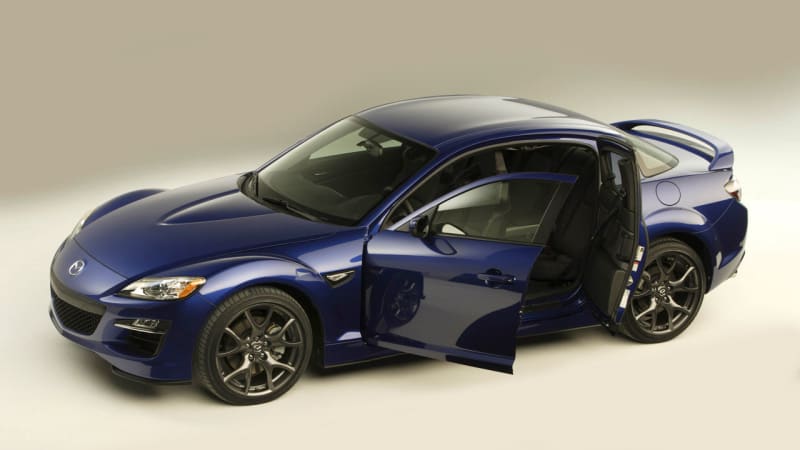There are a lot of good, well-documented reasons not to buy a used Mazda RX-8. We’ll briefly mention a couple of them before moving on to why those real problems might not mean Mazda’s last rotary sports car is a bad used-vehicle purchase. First, due to the Wankel engine’s design, all RX-8s are designed to burn a small amount of oil while running, which isn’t something many owners have been trained to expect. Second, in part due to an effort to reduce emissions as much as possible, the RX-8 earned a reputation of hard starting, flooding, premature engine wear and ultimately expensive repairs. Put simply, if not maintained by a well-informed previous owner, a used RX-8 could be an unreliable headache of a moneypit.
So, why would you ever want to buy one? Let’s discuss.
Why the Mazda RX-8?
We’re not going to sugarcoat the potential pitfalls of this revvy Mazda, but there are some legitimate benefits to rotary-powered cars in general and the Mazda RX-8 in particular. Due to the small dimensions of the firecracker of an engine underhood, the RX-8 was designed with perfect weight distribution, and that means it handles extremely well. When equipped with the desirable manual transmission, the RX-8’s Renesis engine delivers 232 horsepower and revs to 9,000 rpm, and it does so with a pleasing buzz-saw exhaust note and practically zero vibration or harshness. And due to its uncommon four-door design with reverse-opening rear doors, it’s a lot more practical as an occasional people hauler than other small and nimble sports cars.
Plus, likely due at least in part to its reputation as an unreliable heap, the RX-8 quickly depreciated into a price point that makes it extremely attractive to auto enthusiasts on a tight budget.
Which Mazda RX-8 to choose?
For maximum driving pleasure, which is what the sporty Mazda RX-series has always been about, you’re going to want to find one with the manual transmission. Two automatics were offered, the first with four forward speeds and the later with six, but both capped the rev limiter at 7,500 rpm. While that’s still high compared to pretty much every other car sold in America, it takes one of the biggest joys away from the driver: that smooth rush of power as the tach needle swings toward 9K. If you have to have an automatic, choose a later version. Starting in 2006, engine power was bumped from 197 horsepower to 212.
So, stick with the stick. Past that, a few early software kinks were worked out after the first couple of model years, and while most early cars were upgraded and given extended warranties, some buyers may feel more comfortable with a later model. The RX-8 was refreshed for the 2009 model year with a slightly refined styling, a lower rear axle ratio, chassis stiffeners and revised rear suspension geometry that make the 2009-2011 editions the most desirable.
The ultimate RX-8 experience is delivered by the R3 model that was sold for the final three model years. It benefits from most of the Grand Touring model’s luxury goodies but adds Recaro seats, 19-inch wheels and upgraded Bilstein shocks.
Our used vehicle listings can be helpful to find a good deal near you. Narrow the offerings down by a radius around your ZIP code, and pay attention to the deal rating on each listing to see how a vehicle compares with others in a similar area.
What else to consider?
The big problem you’re likely to face when cross-shopping against a used Mazda RX-8 is price. The rotary-engined wonder is generally quite a bit cheaper to buy than pretty much anything you might consider a competitor. The Mazda Miata in any of its generations is extremely fun to drive, but it only seats two occupants. Various Ford Mustang and Chevrolet Camaro models can out-accelerate the RX-8 and may appeal to a similar buyer, but they won’t handle with the overall finesse of the Mazda.
One thing to consider: if you score a solid deal on an RX-8, you could always budget some extra funds for aftermarket support or for a potential engine rebuild if it ever comes to that. Have fun!



